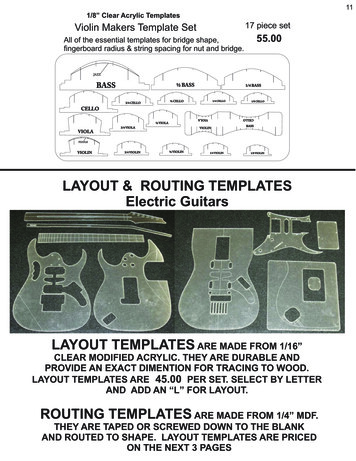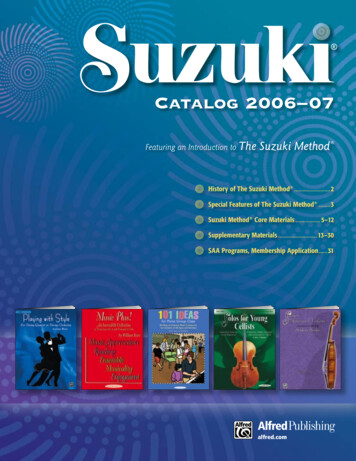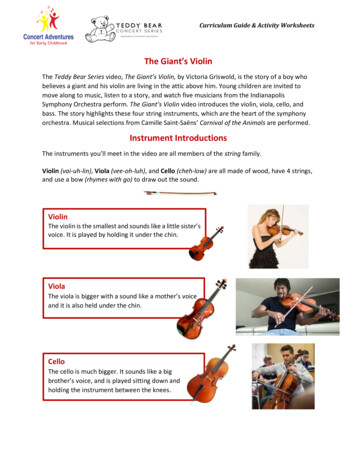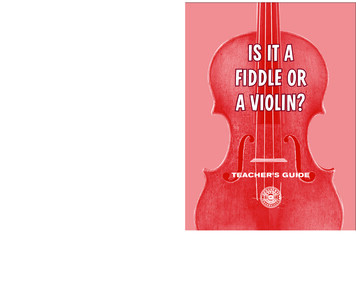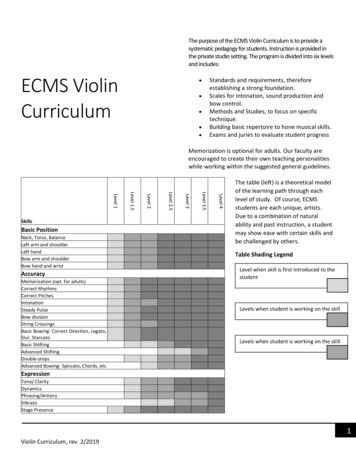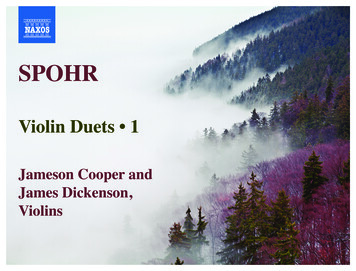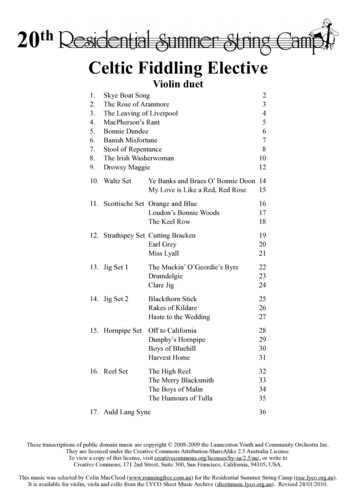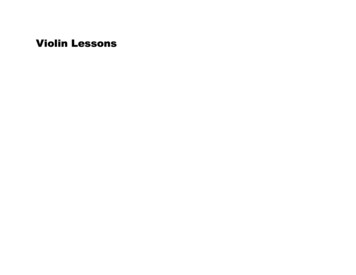
Transcription
Violin Lessons
IntroductionOverview NextViolin is a fantastic instrument. You can play almost any style on a violin. With a violin you may use a night sordine, andpractice without disturbing your neighbors. With a violin you can play in tune without temperature. We shall proof in thiscourse that he old harmonic scales sounds much better for humans than the modern well tempered scales.This course has been translated from the Danish course. It may be a little abbreviated and slightly changed (to the better)with respect to the original.Write to meI would like to hear your opinion. Send an e-mail if you like the course, of if you think I should add something.TopJava ScriptJava Script is used throughout this course. If you have Windows XP service pack 2, the JavaScript will be blocked firsttime you enter a page. You will have to allow the Java Script to run. Please note that the scripts on these pages aretested against Microsoft Internet Explorer only. Some other browsers may not be able to run the scripts. Only some of thepages have the scripts running however.
Sound on the pagesThe sound is using JavaScript as well. You may have to install media packages such as Winamp to be able to hearsound on the pages. Some sounds are coming up when you move the mouse above the link, on other you have to click.On some of the link you should not click, because if you do there is an alternative sound possibility made for non MS IEbrowsers.
About the violin and the bowOverview NextThe frogTension the horsetailrelaxed bowThe horse tail should berelaxed after you have played.Do that by turning the screw atthe frog end of the bow.Bow with tensionthen bow tip
Violin partsThe violin consists The bodyThe fretSnail with tuningknobsString holder with finetunersBridgeCheek holderDon't touch the string partbetween the bridge and thefret board. This will put fingergrease and make it difficult toplay.BridgeString holderfine tuners
Rosin on the bowYou should regularly (at leastonce a week if you arepracticing daily) grease yourbow with rosin. Make sure thatyou apply rosin all over thebow, by moving the rosinseveral times forward andback.The violin "works" because thebow is gripping into the string.Without rosin on the horse tail,the violin will not say anything.Do not touch the horse tail ofthe bow. If the bow becomesgreasy it will not make anysound!
Cleaning the stringGet the resin off the stringusing Propylic alcohol.Top
Tuning of the violinOverview NextPure tonesTempered tonesMouse overMouse overE 660 HzE 659.26 HzA 440 HzA 440 HzD 293.33 HzD 293.66 HzG 195.55 HzG 196 HzClickClickA-D-string(No Beats)A-D-string tempered(1.3 beats per second)D-G-string(No Beats)D-G-string tempered(2 beats per second)E-A string(No Beats)E-A string temped(0.8 beats per second)Use this to run the notes interupted6 secondsstopAbout using a tunerYou may use a tuner if you are starting violin. You will soon realize that a tuner being able to tune the violintempered only, is not ideal. You should be able to tune the violin better than that! Also it is impractical to usea tuner if you are out in noisy environments, where the tuner does not work. As a reference the tuner can bevery useful however.)
How to tuneStart with A-string then he D-string the G-string and finally the E-string. Lift the bow and listen for the beat inthe note. The beat will be explained later.
Holding the violinOverview NextBe relaxed!It is of utmost importance that you relax when playing violinUse a mirrorCheck in the mirror that you are relaxed when playing. It is a goodidea to regularly check your movement in a mirror when youpractice violin. Especially you should focus on being relaxed.Other points of focus are: Is the bow moving perpendicular across the stringsIs the left arm moving correctly as I go down to the lowstringsHow is my right hand moving when the movement of thebow is turning
Hold the violin using your cheeksYou should be able to hold the violin between your cheek andyour shoulder, this allows for the best movement of your fingers.
Left handOverview NextA relaxed hand has curved fingers!Put your left hand on a table. Notice how the thumb and the otherfingers are a little bowed when you are relaxed. You should havethe same position when you put the fingers on the fret board
When you hold the violin the left hand thumb is still curved. Thearm is hanging in the fingers. And the violin is supported by yourcheek and shoulders. Not so much by your left hand.
Left armOverview NextMoving left armThere should be a straight line from your elbowto your fingers. When you are going to play on alower string, you should move the tip of yourelbow forward. When you go back again, youdon't have to think about it! the arm willautomatically move back.
FingersThe fingers should hang at the freeboard. Whenyou get on to the E-string there should be a smalldistance between the index finger and the fretboard. (On the other strings there is no distance)Notice the thumb position. As mentioned thethumb is curved. You do not hold the violin withthe hand, the violin is held with your cheek.
Holding the bowOverview NextRight handYou should have the same point of origin when holding thebow, as when holding the violin. A relaxed hand has curvedfingers!.
Before you start playing you should tighten the hairs of thebow.The bow is kept with an angle away from you. (The hairs areclosest to your face; look at the picture)Look at the lower picture how the thumb is slightly bent.
For startersStarters (children) may hold the thumb under the frog of thebow.
Moving the bowOverview NextLook at this fill how you should move the bow perpendicular across thestringsIf you are playing loud you should move the bow closer to the bridge.
.The famous German mathematician Helmholtz explained how the violin isworking Get the explanation here.
Movement of your right handOverview NextThe right hand is smoothly moving. Check on the film how the wrist starts moving alittle bit before the turning of the bow movement. It is a little bit like when you arepainting using a paint brush.If you study how this movement is done in the mirror, it will be easier to play togetherwith other people later, since you will be able to see when they are making a newnote, before they actually make it.
About the fingering tableOverview NextOn next page you may see the fingering by selecting differentkeysThe page is script basedThere are four basic fingerings on a violin1.2.3.4.There is a half note between 1st and 2nd fingerThere is a half note between 2nd and 3rd fingerThere is a half note between 3rd and 4th fingerNo half notes all fingers are equally separated1.2.Select the "Major scale" dropdown, and move through it with thearrow keys. Can you see there is a pattern? It is because theviolin is tuned in fifth, and the keys are moving in a fifth cycle.Question: Are there other possibilities?3.Answer: Of course yes, if you are playing chromatic scales,moving accidentals or even harmonic minor, you have otherfingerings, but above are the normal ones when playing majorscales4.NoteThe tool works fine in first positions, but in higher positions forEb, Bb, F and C major it jumps a position. This will be fixed innext version of this program.
Playing in tuneOverview NextAbout intervals Interval Overview TunerTo intoneOn a violin it is necessary to intone. If you do not put your finger on the right spot, you will play out of tune. Use your ear. Playingin tune can be learnt, for some people it is easier, but everybody can learn it.There is a number of different intervals coming from the Pythagoras scale the natural scale or the tempered scale.Using a tunerI recommend using a tuner. You will be able to do better than a tuner down the road, but a tuner is not that bad, and if you aregoing to play with other instruments, like harmonicas and pianos you should play the tempered scale anyway.Top
Playing in tune (2)Overview NextAbout intervals Interval Overview TunerCompare with loose stringsWhen you start playing violin you will play in "easy keys" such as C, G, D, and A major. Here it is always possible to find aninterval up against the note you are playing, for checking if you are in tune. Beware of the comma of Didumos. Comparing firstfinger on the A string with E, does not yield the same result as comparing with the D-string. More about this later.The note of Eb does not compare against anything. Here it is nice to have tuner to compare with. Just play the note slowly whenyou are practicing, and learn its position. (The tuner can not follow you as you are playing, but you may stop up for checking) It iseasier to do the check if you have connected a microphone to the tuner, and put the microphone on you violin.
Playing rhythmicallyOverview NextUnfortunately this course has much more pages on how to play in tune than how to play rhythmically correct. It should be theopposite. It is when you play rhythmically you catch the audience. Playing dance music means keeping the beat. It is howeverdifficult to describe in words what a good rhythm is. Here some good hints on how to learn how top play rhythmic:1.2.3.4.5.6.Play together with other peoplePlay for dancersPractice together with CD's, records, mp3's or even the radioFind a good metronomeGet a good feeling for playingGo out and play for people, visit bars, and other places where you may perform your music.When you play it is important to keep a steady beat. But remember that making the rhythm interesting means making smallrhythmical changes between every note. Giving the melody a feel and good phrasing. Using microagoical changes.Play togetherWhen you are playing together with other you are forced to keep a good rhythm.Lean back on the beatThe most common error when playing together is to play faster and faster. This is because if somebody is a little bit before thebeat, everybody will hear that, and feel that they are behind, they try to catch up, but the if guy playing before the beatcontinues to do so, he will also be before the faster beat. When you play before the beat, everybody will here it, because oftenthere is a small pause between every tone. If you lean back and play after the beat, the other people will not hear it in the sameway, because now you are playing in their tone. The trick to lean back is to do it just over some chosen tones, where you wanta special effect, where you want people to listen. Keep up with the basic beat inside you so you do not loose the pulse of themusic.
Play for dancersIt is a privilege to play for dancers. Try to communicate with the dancers while you are playing. Can you feel that they like whatyou are doing. Try to locate the best couple on the floor and follow their movement.Music is communciation. Music and dancegrew up together.Practice with records, CD's or mp3'sFind a good record with some music that you like. If you cannot follow: use a computer program that can slow the music down,without changing the pitch.(There are several programs on the market that can do that.)Don't stop when you have learnt the melody. Try to concentrate on phrases, and agagics. See if you can copy the smallchanges within the rhythm that makes the music to music.Don't be afraid of copying a style. The better you get in your ability to copy other peoples styles, the better you will be to pick upthe style of the people you are playing together with. The better you will get to make a uniform style.Look at it this way: The more styles you learn, the more tools you will have in your bag when you are creating your own stylewhen you are performing.If you are learning from a midi-file, remember that midi music is not music.It does not contain any phrasing making it live. Hereyou have to do the job yourself of putting feelings into the music.MetronomeDon't buy a traditional metronome. They are dull to play with. The best metronome I know is the program Band in a Box. If youare interested in Swedish traditional music, I have made a polska metronome (by using Band in a Box.)I have made some online examples using Band In a box, and put them on my site here and herePractice slowlyWhen you start playing a new melody. Practice slowly. Keep the beet, but do it slowly. Playing slowly in the start is the fastestway of learning how to play fast. Cut the melody into phrases. Practice phrases that are difficult by repeating these phrasesonly. When you feel confident that you now the melody you can gradually increase speed. Make sure that when you are
increasing the speed, that you do it in steps. (So you do not learn how to play accelerando, you should always keep the beatwhen you are playing). You may have to practice the same melody several month until you can play it in it's real tempo.Learn to play fastIt is good to be able to play fast. If you can play fast, you will be more precise also when you are playing slow melodies. Youhave to be very precise in order to play rhythmically correct.Take a simple melody. For example "Soldiers joy". Increase the speed gradually until you can play it really fast. Be sure thatyou are relaxed when you play it. Don't force yourself.Top
Two finger PolskaOverview NextPolska is a Swedish folk song. You should stress 1 and 3 when playing. This polskais particularly simple, you can play it using 2 fingers only.Two finger polskaJust put the mouse above the links for playing and stopping
play melody Stop melodySymbols for bowing up and down.Down means in direction of the point of the bow
To learn melodiesOverview NextWe will now discuss how to learn melodies After having finished this courseUsing sheet musicPlaying CD's records mp3's and radioA teacher or a friendPlaying together with other peopleBy just playing something you have heardOld supernatural methodsAfter having finished this courseI will not put a lot of melodies into this course. If you want to learnmore I can recommend the melody collection at the home page ofFolkets Hus in Nørrebro, Copenhagen where you may find more than1300 Scandinavian folk tunes.If you are interested in playing jazz, I can recommend Band-in-a-Box. Ihave put some examples of jazz music exported to mid format fromBand in a box here.Top
Using note sheetsIt is a good thing to know how to read music sheets for examples if youare going to Folkets Hus collection of notes.But.It is not the best way of learning how to play a melody.The sheet music tells you something but not the full story. It does nottell you how to put feelings into the music. You will experience thatalthough it is fast to be able to play after a music sheet. It takes longertime to learn a melody by heart, if you started reading it. It is muchfaster to learn the melodies by ear if you want to remember them.For learning how to read music I can recommend Band in a box, hereyou get the melodies in both by ear and by sight.Always start playing slowlyWhen you are learning a new piece of music start slowly and increasethe speed slowly. Do not make accelerando as you are playing, butincrease the speed from the start of the melody and play in the speedyou have chosen. If there is a place that is hard to play repeat thatWe have a good collection of Scandinavian folk music at folkets hus,place only.but the music sheets and the midi files does not tell the full story.Top
Playing recorded musicIt is a good idea to listen and play together with records. Especiallylisten for the phrasing. Don't hesitate to copy what you hear. The abilityof copying other people is a good ability to have when you playtogether with other people and you want to unify your sound.Today you may get software that can slow down the music withoutchanging the pitch.Top
By a teacherYou will often be in a situation where you are going to learn a melodyfrom other people or where you are teaching other people First the teacher plays the melody. The pupils should not playnow, only listen.It is a good idea to sing the melody. Singing is often easierthan playing for most peopleThe teacher should split the melody into short strophes whichare learnt by heart. It is a challenge to put the right strophes in,and to repeat them until everybody have them under their skin.Work especially on the difficult ones.You can go on before everybody have learnt the strophe100%. But people should be somehow confident before yougo on.Play the strophes in a slow tempo. The teacher should tell thepupils every time he plays faster, so you do not trainaccelerandos.When you have learnt a full repetition you should play thisrepetition more than twice. Discuss the endings if they aredifferent.When you have learnt the full melody, repeat it many times.Put up the speed slowly. You do not have to reach full speedin a session. If their are ornation, put on the ornation as thelast thing. If there is special phrasing, this should be discussedat this point.TopJust playing alongMost Scandinavian music is quite easy to learn, when you have learntthe style it is quite easy to pick up a new melody. Since all melodiescontains repetitions and dance music is repeated many times, it ispossible to pick a melody up while playing. Make sure that you playvery softly so the total music does not get destroyed by your learningefforts!! Often you may during a melody be aware of where you havedifficulties, and pick the problem notes up one by one for every
repetition.TopJust playing a melody that you have heardSometimes you may just play a melody you have heard. This abilityshould be a goal, then you can play anything at any time. And youhave become a fast learner.Top
Playing togetherOverview NextHaving a conductorIf there is a conductor in the band, you should concentrate on following his will with the music. Below paragraphs are written forbands without a conductorCopy the styleWhen you play with other people. Listen how they are playing. Try to copy their style. When you have done that you can try to"pull" them over to your style. If everybody are doing the same, you will find a common style when you are playing together. Ifyou cannot find a common style, and you feel that you have a style that everybody can unite around, then keep the beat andpromote your styleGive and takePlaying together is a give and take, you give a little of your self and you take a little of what other are giving, in this way mayfind mutual harmony and your music will unify to a common expression.
To play in half circleAs your band grows you may form a half circle. The speed of sound is 330 m/s, if the radius of your circle approaches 10meters, you will have difficulties playing together simply because of the sound delay. (If you are playing 200 Beats per minute)10 meters distance corresponds to a 3-th note in delay. It is possible to play together, but it is difficult to be very precise. 20meters distance corresponds almost to a 16th note in delay it is now almost impossible to play together.A trick is to look at bowing hand of the guy standing on the opposite side of the circle. The speed of light is much faster thanthe speed of sound. So by looking at him you will play simultaneously. Another way of playing together is of course to have aconductor, and look at his movement.Top
PerformingOverview When you play an instrument you don't do it only for yourself, it is also for the audience. Be sure to learn a couple of tunes really good. Theart is not to know a lot of tunes, but a few tunes that you can perform. (If you are often performing for the same audience, you must practicenew tunes, so they do not get tired though).It is a lovely feeling to catch an audience with your instrument. Playing together is not necessarily to play with the other musicians. You canplay together with your audience to. Remember that performing is not only your music. Performing is visual too. Use your body whenkeeping the rhythm. Many musicians use their foot to keep the rhythm. Using your whole body has the advantage that it does not make somuch noise. (In some occasions the foot noise is an advantage for the dancers. However most conductors tend to dislike the stamping.Stop while the play is good. Be aware that not all people like your playing, and it can be boring to listen to. If everybody encourage you toplay continue, but not so long that somebody will ask you to stop. The art of performing includes knowing when to stop.Top
Tones and HarmonyOverview Next
Why include this sectionThe human brain is strange: The more you learn about a subject, theeasier it is to remember. With a violin you can play perfectly in tune. Mostpeople will do that when they are playing alone. While writing this course Irealized that music and mathematics has a lot together. One of thegreatest mathematician Pythagoras, originated his theory in music. Let'sfind out where music is coming from, and how western music intonationand the teaching of harmony has developed through the centuries. We willdiscover something that can be used for understanding how to play intune.Pressure and frequencySound is normally created by vibrations. The string of your violin isvibrating, the vibrations are transmitted via the bridge to the body of theviolin. The violin wood will give resonance (amplification) of the vibration,and the vibrations are transmitted to pressure waves which will reach yourear. Can sound emerge without vibrations? Yes sometimes it can. In aflute for example the pressure vibrations are created by turbulence in theair flow itself.The pressure variations are very small. Air pressure may be measured inPascal Pa which is equivalent of one Newton per square meter. Thesmallest sound that can be heard is a 20 millionth of a Pa. (equivalent of 0dB) When you are playing strong with a violin, your ear may be exposedto 96 dB. The pressure in the atmosphere is about 101.000 Pa. In otherwords you may hear sounds which are variations around a 100 trillionth ofthe atmospheric pressure. Sound is transmitted with a velocity of . 330meters per second. (Dependent on the air temperature this may varyslightly). The tones are oscillations of the pressure. The oscillations aremeasured per second or Hertz (Hz) Children's audible range is from 16Hz to 20.000Hz. When you get older the upper hearing range getreduced.HarmonicsAll tones that are not pure sinusoidal contains harmonics. Harmonics aregenerated from a string because the string can vibrate in different modes,one mode is when the full string is vibrating, another mode is when half
Two notes sounds good together when their harmonic coincides.The old Greek philosophers realized that harmony was produced whenthere were a straight numeric relation between the tension of a string orthe length of the string. They could not count the frequencies, andunderstand why. Today we have frequency analyzers and we have anunderstanding of what causes harmony.Frequency spectrum of the note A and the note E. You can seethat the second harmonic of the E and third harmonic of the Acoincides. This produces a harmony for the ear!
Beats and undertonesOverview NextBeatsWhen two tones with a very small frequency difference are played together, a beat tone will be produced. It sounds like whoh-whoh-whohwhoh-whoh-whoh. The frequency of the beat is equal to the difference in frequency between the two notes.Listen to the tones 659.26 Hz and 660.00 Hz. (The tempered and the pure E sounding together) You can clearly hear 4 beats on the 6seconds of the tones, corresponding to the 0.74 Hz difference between the tones.In the tuning section you may clearly hear the beats in the tempered fifth, when you are listening to the perfect fifth there is no beats!What is beatsSound is pressure waves in the air. The higher the frequency the shorter the wave. The waves are all traveling with the same velocity.When two waves have nearly the same frequency the wave crests of the will sometimes add, sometimes subtract.
On the picture above you can see what the maximum amplitude of the joining of the two tones 659.26 Hz and 660 Hz looks like. You cansee there is 5 distinct beats in the 6 second sequence. Below we have taken out 10 milliseconds and you can see the wave movement byclicking on the link.Start animation Slower Slowly Fast Step Listen to the two tonesOn the picture sequence you can see the two waves some times amplify each other some times they don't
"Undertones"When I started playing I could hear the under tones also remember hearing a strong beat in the undertones when I was playing intervals,or when I played in harmony with my teacher. I asked my teacher what it was and he told me that they does not exist. Today I can nothear them, but my friends tell me they can here them and that they are very useful for tuning your violin.The under tones are created by your ear. When the ear hears a tone it does not only make spectrum analysis it performs a cepstrumanalysis as well. Spectrum analysis is finding periodicity in the time signal. Cepstrum analysis (pronounced with an initial K) is looking forperoidicity in the spectrum. The ear is trained to find the root note of a harmonic sequence. ( In this way you can hear the base in theradio even if the base is played at a low frequency that is not audible through your radio loudspeaker. The ear hears the harmonic seriesof the base, and presumes that the root note is there.)When two tones are played together the ear will see a harmonic series of the difference between the two tones.Spectrum of a A 440Hz and the perfect fifth E 660Hz. We have seen that the harmonics coincides on 3*440 2*660 1320HzFurthermore you see that the two tones forms a harmonic series of 220Hz The root note (220hz) is missing, but the ear may add it as anundertone.The spectrum contains 2. 3. 4. 6. 8. and 9 harmonic of 220 Hz. Note that 5. and 7. harmonic is missing.
PythagorasOverview NextPythagoras scalesPythagoras lived on the island of Samos year 560-480. He believed that everything can be formed in a rational relation.He believed that the movements of the planets were related to music, and he started studying music for finding mathematicalrelations that he later transferred to the laws of the universe.At his time a pentatonic scale was used in Greece.A typical pentatonic scale contains the notes: C, D, E, G, A, CPerfect fifthsBy dividing a string in 3 parts you get a fifth higher. Pythagoras took the fifth and divided it again. When you have done that fivetimes you would get all the notes of the pentatonic scale.The pupils of Pythagoras went on until they had formed our present 7 tone scale . C, D, E, G, A, B, C.By continuing to put fifth on top of each other you may create a twelve tone scale.
Find the fifth by dividing the stringYou may easily produce a pure octave and a pure fifth on your violin.1. Hold the finger above the string just touching the string at about half thestring.2. Make sure to bow close to the bridge.3. You will create a flageolet note (the word flageolet comes from French:flute, it is because the tone produced in this manner sounds a little bitlike a flute) with a pitch one octave higher.4. Try the same technique were you normally put your fourth finger. Youwill get a note sounding one octave and a fifth higher. The string is nowdivided in three equal parts.
The circle of fifthsOverview NextOur western scale system is partly built on Pythagoras findings.The neighboring keys in the circle are correspondinglysubdominant and dominant of the key in the middle.
Tempered scaleOverview NextDisadvantages of the Pythagorean and harmonic scalesThe harmonic and Pythagorean scales sounds very good when you play in the in one to 3 keys, but as you start modulate into all 12 keysit does not sound very nice.The tempered scaleIn the 17th century people wanted to make pianos and organs that could play in any key. The German organ builder AndreasWerckmeister made a system where he detuned every note systematically. He listened to the beat in the fifth and correlated the samebeat in all fifth. Today we use a mathematical way of deriving the tempered scale.This allowed to play in all keys. In the beginning there was a discussion. Because the tempered organ did not sound as good as the organtuned the Pythagorean or the harmonic way, when playing in the basic key. Johannes Sebastian Bach solved the dispute by composing amelody that modulated into all 12 keys. This could only be played on the new instruments, so all instruments had to be tuned to the newprinciples if you wanted to play the new music.Today all pianos, harmonicas and synthesizers are tuned in the tempered scale. So if you are playing together with these instruments,you should play tempered
How to derive the tempered scaleThe frequency is inverse proportional with the string length, so let us derive it frequency based.The problem is to find a number that multiplied with it self 12 times yields a doubling of the frequency corresponding to an octave.The equation looks like thisX*X*X*X*X*X*X*X*X*X*X*X 2orX 1.059463094 about 6% higher pitch.In string lengththis yieldsor 94,38% shorter string for each semitone.The square root of a number is the number that multiplied with itself yields the number. The twelfth root is the number that multiplied withitself twelve times yields the number. You may get the twelfth root on a scientific calculator by taking the number to the power of 1/12th.
About the interval listOverview Next (to to the interval list The next page is using Javascript .On the next page you will find 39 intervals Pure natural intervalsIntervals of the harmonic scaleIntervals of the Pythagorean scaleTempered intervals.You will be able to listen to the tones/ intervals by either moving your mouse across them or clicking.In the beginning you must try the notes twice. Th
violin is tuned in fifth, and the keys are moving in a fifth cycle. Question: Are there other possibilities? Answer: Of course yes, if you are playing chromatic scales, moving accidentals or even harmonic minor, you have other fingerings, but above are the normal ones when playing major scales 1. 2.File Size: 1MB


